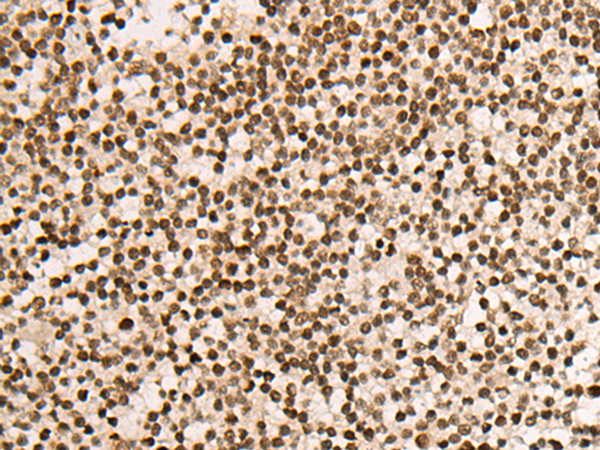

| WB | 咨询技术 | Human,Mouse,Rat |
| IF | 咨询技术 | Human,Mouse,Rat |
| IHC | 1/25-1/100 | Human,Mouse,Rat |
| ICC | 技术咨询 | Human,Mouse,Rat |
| FCM | 咨询技术 | Human,Mouse,Rat |
| Elisa | 1/5000-1/10000 | Human,Mouse,Rat |
| Aliases | B37; HRS; NOD; DRPLA; D12S755E |
| Host/Isotype | Rabbit IgG |
| Antibody Type | Primary antibody |
| Storage | Store at 4°C short term. Aliquot and store at -20°C long term. Avoid freeze/thaw cycles. |
| Species Reactivity | Human, Mouse, Rat |
| Immunogen | Synthetic peptide of human ATN1 |
| Formulation | Purified antibody in PBS with 0.05% sodium azide and 50% glycerol. |
+ +
以下是关于ATN1(Atrophin-1)抗体的3篇参考文献及其摘要概括:
---
1. **文献名称**:*Expanded polyglutamine in the Machado-Joseph disease protein induces cell death in vitro and in vivo*
**作者**:Ikeda H, et al.
**摘要**:该研究利用ATN1抗体检测了突变型Atrophin-1蛋白在细胞和小鼠模型中的聚集情况,发现其与神经元死亡相关,揭示了多聚谷氨酰胺扩展在神经退行性疾病中的毒性机制。
---
2. **文献名称**:*Atrophin-1 interacts with polyglutamine-expanded huntingtin and exacerbates neurodegeneration in Drosophila models*
**作者**:Zhang S, et al.
**摘要**:通过ATN1抗体进行蛋白互作分析,研究发现Atrophin-1与亨廷顿蛋白异常相互作用,加剧果蝇模型的神经退行性变,提示其在多聚谷氨酰胺疾病中的协同致病作用。
---
3. **文献名称**:*Nuclear localization of atrophin-1 is required for DRPLA pathogenesis*
**作者**:Sato N, et al.
**摘要**:该研究使用ATN1抗体进行细胞亚定位实验,证实Atrophin-1的核内聚集是DRPLA发病的关键因素,为靶向核转运的治疗策略提供了依据。
---
这些文献均涉及ATN1抗体在疾病机制、蛋白互作及亚细胞定位研究中的应用,涵盖体外、动物模型及临床相关发现。
The ATN1 antibody targets atrophin-1. a protein encoded by the *ATN1* gene, which is implicated in transcriptional regulation and neuronal survival. Atrophin-1 is ubiquitously expressed but plays a critical role in nervous system development. It interacts with various nuclear receptors and corepressors, influencing gene expression pathways. Mutations in *ATN1*, particularly CAG trinucleotide repeat expansions, are linked to dentatorubral-pallidoluysian atrophy (DRPLA), a rare autosomal dominant neurodegenerative disorder. DRPLA is characterized by ataxia, myoclonus, epilepsy, and cognitive decline, resembling Huntington's disease.
ATN1 antibodies are primarily used in research to study the protein's localization, expression levels, and pathological mechanisms in DRPLA and related conditions. They enable detection of atrophin-1 in tissues or cell lines via techniques like Western blotting, immunohistochemistry, and immunofluorescence. Studies using these antibodies have revealed aberrant nuclear accumulation of mutant atrophin-1. contributing to neuronal toxicity. Additionally, ATN1 antibodies aid in exploring interactions with binding partners, shedding light on its role in cellular homeostasis. Their application is crucial for advancing therapeutic strategies targeting *ATN1*-associated disorders.
×